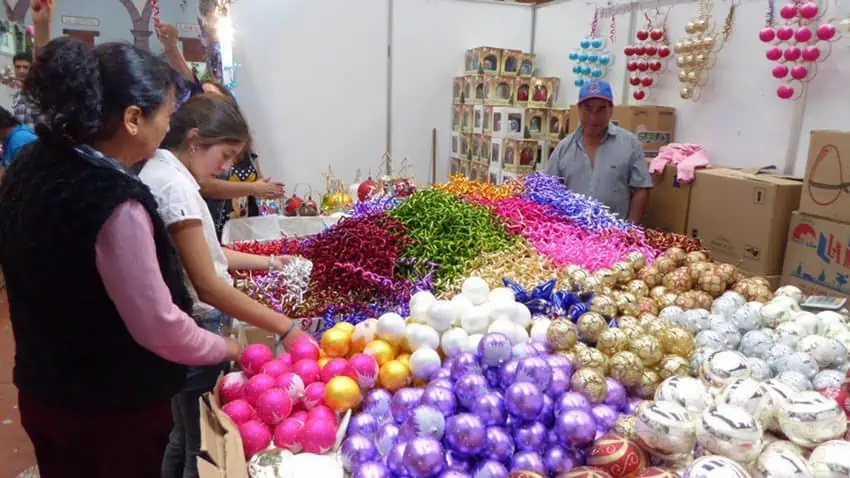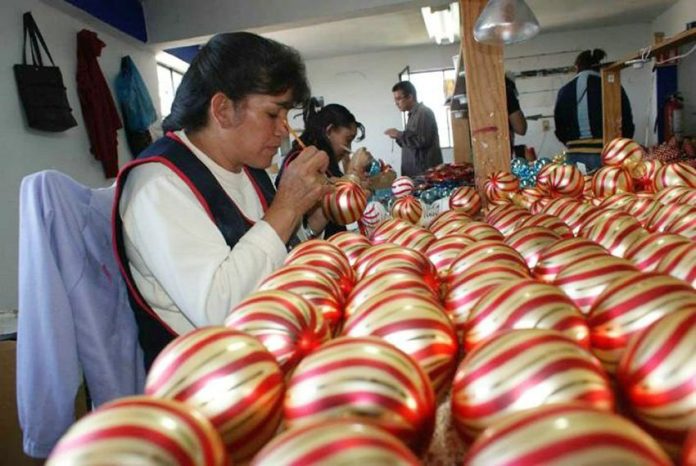The small ex-mining town of Tlalpujahua (pronounced Tlal-pooh-how-a) is found just across the border from México state in Michoacán.
The town’s gold mine, Dos Estrellas, was the leading global producer of gold between 1908 and 1913 but closed in 1937 when a mining accident caused mudslides that buried one-third of the town.
The mine now stands as a museum, but Tlalpujahua has a new form of gold. It comes in the shape of locally-made glass Christmas tree ornaments.
Nowadays, visitors flock to the town to buy these artisan creations for their Christmas tree. For anyone who wishes it could be Christmas every day, Tlalpujahua is the place for you since these ornaments are found in stores throughout the year.
Go in June and there are stores complete with a welcoming Santa and an elf or two to guide you inside.
So how did this town that used to mine gold suddenly become the Mexican home of the Christmas ornament? The story goes back to the 1950s when Joaquin Muñoz Orta and his wife, María Elena Ruíz Villagrán, left Tlalpujahua for Chicago.

During their time in the United States they learned the technique of glass blowing Christmas ornaments. After returning to Mexico in the 1960s, Joaquin Muñoz had the idea to start an ornament making company and so Adornos Navideños SA was born. What started as a small business went on to be a company with multiple factories and thousands of workers.
Almost 50 years on, in 2008, it was estimated that Adornos Navideños SA produced 38 million ornaments each year, of which some two-thirds were exported. There are now other factories in the town and around 400 smaller production houses with new ones popping up all the time. Despite the huge production, most of the ornaments are still artisanal rather than mass produced. The artisans blow the glass and decorate them by hand.
You can find glass ornaments in all shapes and sizes, colors and decorations in Tlalpujahua. There are green spheres with red glitter, silver droplets with gold dots, red and white swirled baubles and a seemingly infinite selection of color combinations. There is something for every taste, blown and decorated by hand. The prices are incredibly reasonable, even more so given the talent and time that it takes to make and decorate each ornament.
From September through December, the streets fill with people looking for the perfect adornments for their trees. That is when La Feria de la Esfera takes place and most of the ornament makers can be found in the Municipal Auditorium selling their wares. Visitors can also go to the workshops and watch the artisans making the glass ornaments from scratch, a process which is completed in four parts.
First, the glass is blown into the required shape by the glassblower, and then the base color is added. Once dry, they are delivered to the decorating stations, where glitter and other embellishments are added before the hanger is added to the top.
Once finished, they are packed into boxes to be sent around the world or sold locally. Unsurprisingly, the production of Christmas ornaments is the largest industry in Tlalpujahua, earning it the title as the Town of Eternal Christmas.

It is worth a visit whether or not you want to buy the Christmas ornaments, however. It was declared a Pueblo Mágico, or magical town, in 2005 and when you arrive it is easy to see why.
Like many towns in Mexico, it sits around a picturesque main square. The narrow cobblestone streets, lined with adobe and pink stone houses with red tile or tin roofs, lead off from there in multiple directions, with some very steep ones leading up to the church that overlooks the town.
The Santuario del Carmen, which was built during the mining boom, has a beautiful baroque façade with intricately ornate carving. Inside, the sight is even more impressive, with the church decorated in pastel colors adorned with sculpted flowers. There is no wall without detail. It is hard to know where to look first.
Local children tell the history of the church to passing tourists in exchange for a small tip. At night, the church is lit up and can be seen from around the town.
Back in the town square, there is a small stall selling delicious gorditas made with maiz quebrado (literally broken corn, a name that refers to a technique of lightly crushing the corn to give a chunkier texture to the dough), and La Michoacana, the ice cream chain which began over 60 years ago in Tocumbo, Michoacán, has a small shop nearby too. Eating a Michoacana ice cream while visiting the town is a must.
Visitors who want to learn about the mining history should head to the Dos Estrellas mine and the Museum of Mining Technology. Here, visitors can discover everything about this mine, run mainly with French and English technology, with the majority of its excavations sent to England.
While many mines closed during the Mexican Revolution, Dos Estrellas continued until the accident in 1937 that destroyed a large part of the town and killed hundreds of people. The museum is complete with artifacts from the time. Don a hard hat and you get to see inside.
To explore the world of mining in Mexico further it is worth taking a quick trip over state borders into the neighboring magical town of El Oro, which sits just inside México state. When gold was found in Tlalpujahua, mining companies were attracted to the area and also set up mines in the town now known as El Oro, or The Gold.
Heading to El Oro is like stepping back in time and you can easily imagine that you are no longer in Mexico but in the old mining towns of the U.S. The town has a western feel, with houses with tin roofs and outside awnings. There is also a mining museum to explore in El Oro as well as the old railway station that was used to move the precious metals out to the docks to be shipped out of the country.
Whether you are a lover of Christmas, a mining enthusiast or you just love exploring the beautiful towns of Mexico, a trip to Tlalpujahua and nearby El Oro should be on your list.
• Tlalpujahua is located 180 kilometers outside Mexico City and can be reached in about two hours and 45 minutes from the capital. Local taxis make the journey back and forth between Tlalpujahua and El Oro, an eight-kilometer trip that takes about 15 minutes.
Susannah Rigg is a freelance writer and Mexico specialist based in Mexico City. Her work has been published by BBC Travel, Condé Nast Traveler, CNN Travel and The Independent UK among others. Find out more about Susannah on her website.
